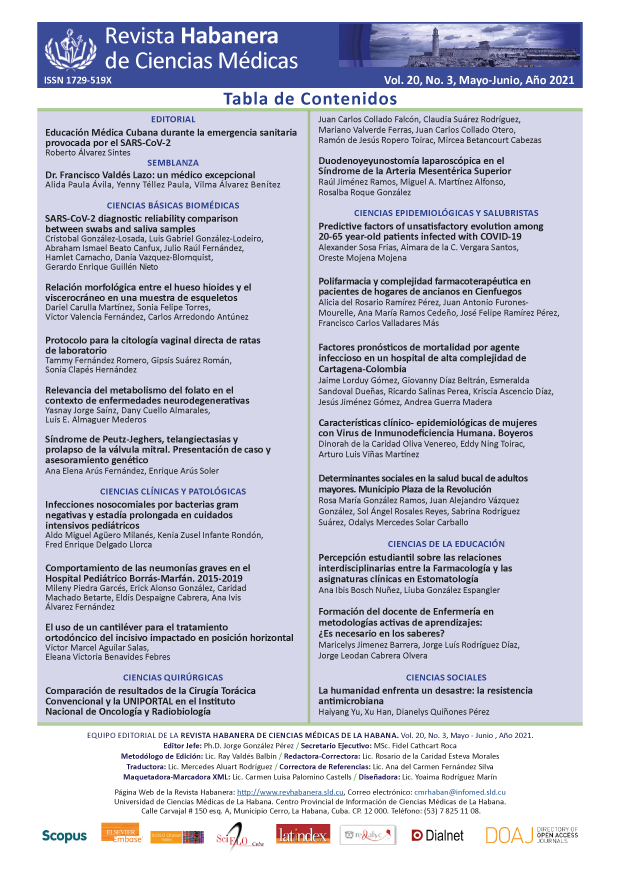Morphologic relationship between the hyoid bone and the viscerocranium in a sample of skeletons
Keywords:
Hyoid, bone growth, anthropology.Abstract
Introduction: Body movement obeys and produces activity in the skeletal muscle for which there must be a static muscle equilibrium that produces the movement of the anatomic elements involved in it, either as a result of volition or as the unconscious perception of a stimulus.
Objective: To associate the morphological behavior of the hyoid bone with some morphological variables of the viscerocranium of skeletons (except the jaw).
Material and Methods: An osteological study was carried out in a bone sample of 82 skulls by performing morphometric measurements of the hyoid bone and the bones of the viscerocranium. Pearson’s correlation coefficient and SPSS Version 22 were used to evaluate the relationship between the morphology of the hyoid bone and the facial bones. Morphological variables of the viscerocranium include: bizygomatic width (BW), external transverse width of the hard palate (ETWHP), external sagittal width of the hard palate (ESWHP), and the height of the middle third of the face (MTF).
Results: A very strong positive correlation between different morphological variables of the hyoid bone, —both at the level of its antlers or greater horns— and the morphological variables of the viscerocranium was obtained.
Conclusions: These findings corroborate the association between the hyoid bone and the growth of facial bones.Downloads
References
1. González Rodríguez S, Llanes Rodríguez M, Batista González N, Pedroso Ramos L, Pérez Valerino M. Relación entre oclusión dentaria y postura cráneo-cervical en niños con maloclusiones clase II y III. Rev Méd Electrónica [Internet]. 2019 [Citado 28/08/2019];41(1):63-78. Disponible en: https://www.revistamedicaelectronica.sld.cu/index.php/rme/article/view/2669/html_570
2. Carneiro PR, da Silva Teles LC. Influence of postural alterations, followed by computadorized photogrammetry, in the voice production. Brasil Fisioter Mov Curitiba [Internet]. 2012 [Citado 28/08/2019];25(1):13-20. Disponible en: https://doi.org/10.1590/S0103-51502012000100002
3. Ries LGK, Bérzin F. Cervical pain in individuals with and without temporomandibular disorders. Brazilian J of Oral Sciencies [Internet]. 2016 [Citado 28/08/2019];15:1301-7. Disponible en: http://www.fop.unicamp.br/bjos-new/index.php/bjos/article/view/830
4. Camargo Prada D, Olaya Gamboa E, Torres Murillo E. Teorías del crecimiento craneofacial: una revisión de literatura. Rev UstaSalud [Internet]. 2017 [Citado 28/08/2019];16:78-88. Disponible en: https://revistas.ustabuca.edu.co/index.php/USTASALUD_ODONTOLOGIA/article/view/2022.
5. Rouviére H, Delmas A. Anatomía Humana. Descriptiva, Topográfica y Funcional. 11 ed. Barcelona, España: MASSON S. A.; 2006.
6. Panchioni FSM, Aoyama AY, Pavia A, Pernas DL, Ulises Savian N, Prado Teles, et al. Difunçao temporomandibular: análice cefalométrica e fotogrametria. ConScientiae Saúde [Internet]. 2013 [Citado 28/08/2019];12(2):177-84. Disponible en: https://doi.org/10.5585/ConsSaude.v12n2.4139
7. Adhani R, Widodo AM. Differences between male and female dental arch form. Dentino J.Kedokteran Gigi [Internet]. 2017 [Citado 28/08/2019];II(1):12-5. Disponible en: http://eprints.ulm.ac.id/2305/
8. Proffit W, Field H, Sarver D, Ackerman J. Ortodoncia Contemporánea. 5 ed. Barcelona. España: ELSERVIER. SA; 2019.
9. Espinosa Gómez MÁ. Relación entre postura cráneo-cervical, posición del hioides y respiración oral [Tesis de Especialidad en Odontología]. España: Universidad de Sevilla; 2015 [Citado 28/08/2019]. Disponible en: https://idus.us.es/handle/11441/69123
10. Molina PL, Barbé PP, Bufadel AG, Acevedo EC, Frugone ZRE. Plantar center of pressure and postural balance according to head anteposition. Rev Fac Odont. Univ d Antioquia [Internet]. 2016 [Citado 28/08/2019];28(1):1-6. Disponible en: http://doi.org/10.17533/udea.rfo.v28n1a6
11. Shrestha B, Mogra S, Shetty S. Role of suprahyoid muscles in the growth pattern of mandible. Journal of Nepal Dental Association [Internet]. 2009 [Citado 28/08/2019];10(1):3-11. Disponible en: https://www.ajodo.org/article/S0889-5406(02)00091-4/pdf
12. Soheilifar S, Momeni MA. Cephalometric Comparison of Position of the Hyoid Bone in Class I and Class II Patients. Iran Journal of Orthodontic [Internet]. 2017 [Citado 11/11/2019];12(1):e6500-5. Disponible en: https://pdfs.semanticscholar.org/b613/5d36ebaca48b51db3125ad58dce9f4dc3806.pdf
13. Carulla Martínez D, Espinosa Quiroz D, Mesa Levy T. Estudio cefalométrico del hueso hioides en niños respiradores bucales de 11 años. (Primera parte). Revista Cubana de Estomatología [Internet]. 2008 [Citado 23/03/2016];45(2):1-13. Disponible en: http://scielo.sld.cu/pdf/est/v45n2/est07208.pdf
14. Marchena Rodríguez AJ. Relación entre la posición del pie y maloclusiones dentales en niños de 6-9 años de edad. [Tesis Doctoral]. España: Universidad de Málaga; 2018 [Citado 23/03/2020]. Disponible en: http://hdl.handle.net/10630/17321
15. Torre Martínez H, Menchaca F P, Froles Leal V, Mercado Hernández R. Implicaciones en el crecimiento y desarrollo cráneo-facial por ausencia del hueso hioides. Ciencia UANL [Internet]. 2004 [Citado 11/03/2015];VII(001):60-5. Disponible en: http://eprints.uanl.mx/1602/1/hueso_hioides.pdf
16. Camargo Prada D, Olaya Gamboa E, Torres Murillo E. Teorías del crecimiento craneofacial: una revisión de literatura. Rev UstaSalud [Internet]. 2017 [Citado 28/08/2019];16:81-2. Disponible en: https://revistas.ustabuca.edu.co/index.php/USTASALUD_ODONTOLOGIA/article/view/2022



